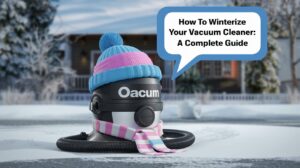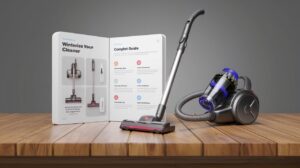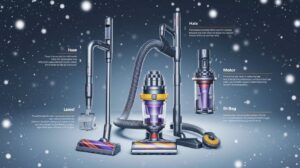How to Winterize Your Vacuum Cleaner: A Complete Guide
I. Introduction
As winter approaches, homeowners often face the challenge of extra dirt, salt, and moisture brought indoors. One of the best ways to maintain a clean home is by properly maintaining your vacuum cleaner. Winterizing your vacuum cleaner helps ensure it continues to work efficiently during the colder months while preventing unnecessary wear and tear.
The harsh winter conditions can put extra strain on your vacuum, with snow, mud, pet hair, and moisture causing issues like clogged hoses, reduced suction, and motor damage. Vacuum cleaner winter care is essential to prolong the life of your appliance and keep it running smoothly. By taking the right steps now, you can avoid costly repairs and ensure your vacuum stays in good shape through the season.
This guide will provide you with step-by-step instructions to winterize your vacuum cleaner, from cleaning filters to proper storage techniques. Let’s explore how simple maintenance steps can make a significant difference in the longevity and performance of your vacuum cleaner during the winter months.

II. Understanding Winter Wear and Tear on Your Vacuum Cleaner
Winter can be particularly hard on your home appliances, especially your vacuum cleaner. As snow, salt, and mud are tracked inside, your vacuum cleaner is exposed to more dirt and debris than usual. These elements, along with moisture, can negatively impact the performance and longevity of your vacuum. Winterizing your vacuum cleaner starts with understanding the specific challenges the cold months bring.
Increased dirt and moisture are among the biggest culprits when it comes to winter wear and tear. During winter, salt from sidewalks and roads can be tracked into your home, where it quickly accumulates on floors and carpets. This salt can cause corrosion within the vacuum cleaner if it’s not properly cleaned or maintained. In addition to salt, moisture from snow and rain can also build up in the vacuum’s hose, filters, and motor. If moisture is left unchecked, it can result in mold growth or electrical issues that could permanently damage your vacuum cleaner.
Pet hair is another significant factor that can affect your vacuum during the winter months. In many households, pets tend to shed more in colder weather. As the temperature drops, your furry friends may also spend more time indoors, leading to an increase in pet hair around the house. If not regularly cleaned, pet hair can clog your vacuum’s brush roll, filters, and hose, severely affecting suction power and making it harder to clean your floors effectively.
Winter conditions also mean that your vacuum cleaner will be used more frequently. As you attempt to keep your home clean and free of the grime, dirt, and debris from the outside, your vacuum will be working overtime. This increased usage can cause unnecessary wear on the vacuum’s motor, brush rolls, and belts, especially if the appliance isn’t properly maintained or winterized.
Understanding these challenges is crucial in ensuring your vacuum remains in optimal condition throughout the winter. The best way to prevent long-term damage is to give your vacuum the attention it deserves before the season gets in full swing. Vacuum cleaner winter care involves preparing your appliance for the unique conditions of winter, from moisture to extra debris. Taking the time to perform simple maintenance tasks now will save you from potential headaches down the line.
III. Step-by-Step Guide to Winterizing Your Vacuum Cleaner
Winterizing your vacuum cleaner is a straightforward process that involves several key steps to ensure it remains effective during the colder months. By taking a little extra time to care for your appliance, you can extend its lifespan and keep it functioning at peak performance. Below, we’ll guide you through the essential steps in vacuum winter maintenance.
A. Cleaning and Checking the Filters
The first step in winterizing your vacuum cleaner is to clean or replace the filters. Filters are essential in trapping dirt, debris, and allergens, and when they become clogged, they can decrease suction power. During the winter months, when dirt and salt are tracked in more often, it’s important to check your filters regularly. Simply remove them according to your vacuum’s instructions and either clean or replace them if necessary. If your vacuum uses a HEPA filter, make sure to replace it as it can become more susceptible to clogging during winter, reducing its effectiveness.
B. Inspecting the Vacuum’s Hoses and Cords
Next, inspect your vacuum’s hoses and cords for any signs of wear or damage. Cold temperatures and moisture can cause rubber hoses to crack or become brittle over time. Carefully check for any blockages in the hose that might have accumulated from dirt, pet hair, or salt. If you notice any debris, carefully unclog the hose with a soft brush or by pushing it through with a long object like a broomstick. It’s also a good idea to check the vacuum’s power cord for any exposed wires or fraying that could cause an electrical issue. Ensure the cord is coiled loosely and stored safely to avoid unnecessary damage.
C. Caring for the Brush Roll and Belt
Your vacuum’s brush roll and belt work together to pick up dirt and debris from your floors. However, during the winter months, they’re often exposed to more pet hair and stubborn dirt, which can become tangled. Turn off your vacuum and remove the brush roll to carefully clean away any hair or debris. If your vacuum has a brush roll belt, check it for any signs of wear, cracks, or looseness. A loose or broken belt can affect suction power and cause the motor to overheat, so make sure it is intact and functioning properly.
D. Moisture Protection
Winter moisture is one of the biggest threats to your vacuum cleaner, as it can lead to mold and rust. To prevent this, always ensure your vacuum is completely dry before storing it. After use, especially on wet floors, allow the vacuum to dry thoroughly before putting it away. If your vacuum has been exposed to moisture from snow or rain, open it up to air dry the internal components. This small step in vacuum winter maintenance will keep your vacuum from experiencing moisture-related damage.
By following these steps, you can significantly improve your vacuum’s performance and longevity during the colder months. Regular maintenance, such as cleaning the filters, inspecting the hoses and belts, and protecting your vacuum from moisture, will ensure that your vacuum cleaner is ready for the extra wear and tear of winter.

IV. Storing Your Vacuum Cleaner During Winter
Proper storage is an essential aspect of winterizing your vacuum cleaner to ensure it stays in great working condition throughout the season. Storing your vacuum incorrectly can lead to a variety of issues, from moisture damage to motor problems. To avoid these issues, it’s important to follow the best practices for vacuum winter care when putting your appliance away.
A. Choosing the Right Storage Spot
The location where you store your vacuum cleaner plays a significant role in its longevity. Always store your vacuum in a dry, cool place, away from excessive heat or humidity. Exposure to extreme temperatures, both hot and cold, can cause materials like rubber hoses, belts, and cords to deteriorate more quickly. A storage area that is too damp can lead to rust and mold, particularly in the motor and internal parts. Therefore, choose a spot that’s well-ventilated and protected from moisture to prevent unnecessary wear.
B. Proper Storage Practices
When storing your vacuum cleaner during the winter, take care to coil the power cord properly. Avoid winding the cord too tightly, as this can cause wear or even breakage over time. If your vacuum has a retractable cord, ensure that it’s retracted properly and not left in a loose coil that could become tangled. Additionally, elevate your vacuum off the ground if possible. This will prevent it from coming into direct contact with wet or salty floors that may contribute to corrosion. By following these simple storage practices, you can prevent damage to the vacuum and keep it ready for use when you need it.
Proper storage not only helps your vacuum last longer but also ensures that it will perform optimally when you bring it out for the next cleaning session. Taking the time to store it correctly will protect it from unnecessary damage caused by harsh winter conditions.
V. Other Winter Care Tips
In addition to regular cleaning and storage, there are a few more winter care tips that can help keep your vacuum in excellent condition. As your vacuum cleaner works harder during the winter months, it’s important to monitor its performance and take proactive steps when issues arise.
A. Monitor for Performance Issues
One of the easiest ways to ensure your vacuum is running smoothly is to regularly check its performance. Pay attention to changes in suction power, noise levels, or any unusual smells during operation. A decrease in suction power might indicate that the filters or hoses are clogged with dirt or debris, while strange noises could point to a problem with the brush roll or belt. Addressing these issues promptly can prevent further damage and ensure your vacuum is always ready to clean. Vacuum cleaner troubleshooting should be a regular part of your winter maintenance routine to catch small problems before they become bigger issues.
B. Regular Maintenance
Winter can be harsh on your vacuum cleaner, so it’s important to perform regular maintenance. Set up a cleaning schedule to ensure that your vacuum is always functioning at its best. Clean the filters and brush rolls regularly, and check the hose for any debris that could clog it. Additionally, if you notice any wear on the belts or motor, take immediate action to replace them before they break. Regular maintenance will extend the life of your vacuum and help it perform better, even during the most challenging winter months.
Taking care of your vacuum during the winter is key to ensuring it remains an effective cleaning tool. Whether you’re addressing performance issues or sticking to a regular cleaning schedule, these additional winter care tips will help you keep your vacuum in top shape.
VI. Common Mistakes to Avoid When Winterizing Your Vacuum
While winterizing your vacuum cleaner can prolong its life and improve its performance, there are some common mistakes that homeowners should avoid. Making these mistakes can lead to further damage or reduced efficiency, especially during the harsh winter months.
A. Overlooking Regular Maintenance
One of the most common mistakes when winterizing a vacuum cleaner is neglecting regular maintenance. Even during the colder months, it’s essential to perform routine checks and cleanings, such as replacing or cleaning the filters and inspecting the hose for blockages. Vacuum cleaner winter care doesn’t mean just preparing the appliance for winter but ensuring ongoing care throughout the season. Skipping these tasks can lead to long-term damage, such as motor strain, clogged filters, and poor suction.
B. Using Harsh Chemicals
When cleaning your vacuum cleaner, it’s important to use the right tools and cleaning agents. Some homeowners may use harsh chemicals or abrasive cleaners in an attempt to deep clean their vacuum. However, using strong chemicals can cause damage to sensitive parts like the motor, hose, or filter, which are crucial for maintaining optimal suction power. Stick to manufacturer recommendations and use mild cleaning solutions or water when cleaning internal components.
C. Storing the Vacuum in Damp Conditions
Another common mistake is storing the vacuum in a damp or excessively humid area. Winter often brings higher humidity levels, and storing your vacuum in places like basements or garages can expose it to moisture, which may lead to rust or mold buildup. Always store your vacuum in a dry, climate-controlled space to avoid moisture-related damage. Vacuum winter storage is crucial for keeping your appliance in good working condition and preventing issues caused by dampness or temperature fluctuations.
Avoiding these mistakes will help you ensure that your vacuum cleaner continues to perform well throughout the winter. By sticking to a proper maintenance schedule, using the right cleaning methods, and storing your vacuum in the ideal conditions, you can extend its lifespan and improve its efficiency.

VII. Conclusion
Winterizing your vacuum cleaner is an essential task to ensure it continues to operate effectively and lasts longer during the colder months. By taking the time to clean the filters, inspect the hoses and cords, and protect your vacuum from moisture, you can avoid costly repairs and maintain peak performance. Vacuum cleaner winter care doesn’t have to be complicated—it’s all about the little steps that make a big difference in the long run.
As you prepare for winter, remember the importance of regular maintenance. This includes checking the brush rolls, cleaning out pet hair, and keeping an eye out for performance issues like reduced suction. Winterizing your vacuum cleaner isn’t just about protecting your appliance—it’s about ensuring your home stays clean, warm, and inviting throughout the season.
In conclusion, a little proactive care goes a long way in keeping your vacuum cleaner in top shape during the winter months. By following these steps, you’ll not only protect your vacuum but also save time and money in the long run. So, get started today and enjoy a hassle-free winter with a fully functional vacuum cleaner!